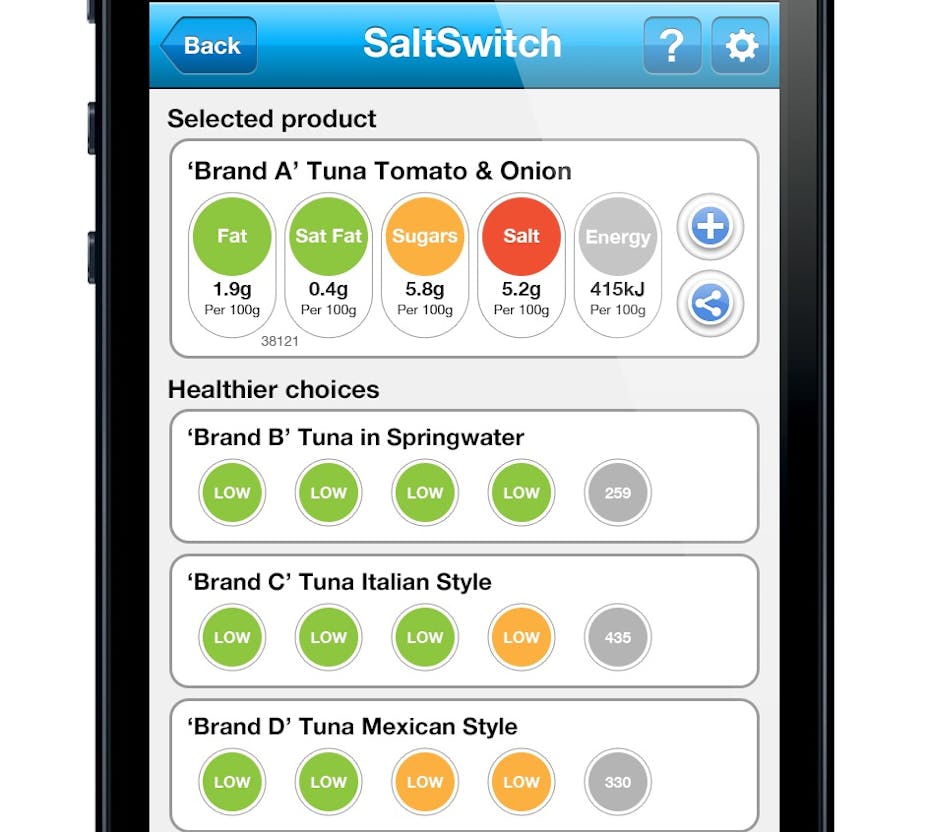The global burden of disease data released last week shows that salt is a leading cause of death and disability, and may be responsible for 9.5 million deaths annually. Whilst the most effective way to reduce salt consumption is for manufacturers to take it out of foods and meals, tools to help consumers select lower salt foods also play an important role.
We have today launched an app called SaltSwitch, which is one way to empower people who want to reduce their salt intake.
The evidence in support of the health benefits of salt reduction is so compelling that national and international government and medical organisations are increasingly identifying it as a priority policy.
The National Health and Medical Research Council has been promoting salt reduction since 1984. The National Heart Foundation this year published a strategic plan prioritising salt reduction and is pushing for stronger government action on this issue.
The American Heart Association is calling on the US government to commit to reducing population salt intake. And, the World Health Organization is on the brink of agreeing a target for member states to reduce salt intake by a third to reduce the burden of non-communicable diseases.
A recent review of government action identified 32 countries with national salt reduction strategies in place and this number is increasing. And South Africa recently became one of the first countries to legislate for maximum salt levels in certain foods.
The Fijian Ministry of Health is supporting a program of work with industry, backed by a consumer education campaign (including television commercials), to reduce salt consumption. The UK government this year announced that it had successfully achieved a further reduction in population salt intake meaning the United Kingdom now has the lowest average salt intake (8.1 grams a day) of a developed country. Tens of thousands of lives a year are now being saved as a result of this strategy.
The question is no longer whether we need to reduce salt but how best to do it. Key elements of most salt-reduction strategies to date include working with the food industry to encourage them to reduce salt in foods and meals. This work is usually done in parallel with campaigns to change consumer behaviour and initiatives to highlight salt levels on labels.
Warnings on foods were key to successful salt reduction in Finland in the early 1980s and traffic-light labels have been the main element of the successful UK campaign. Traffic light labels interpret the amount of salt, fat and sugar in a product using red (high), amber (medium) and green (low) symbols.
The Australian government is currently negotiating a solution to the impasse on labelling, which for years pitted the industry’s percentage of daily intake labels against public health groups, which tend to favour interpretive colour-coded schemes such as traffic lights.
The George Institute for Global Health, where I work has just launched the SaltSwitch smart phone app, in collaboration with Bupa Australia. SaltSwith is a new version of the FoodSwitch app that helps shoppers to interpret food labels to make healthier choices.
The app allows people to scan the barcode of a product to get nutritional information about it in an easy-to-understand traffic-light format. Not only does this enable people to see at a glance whether something has high (red light) medium (amber light) or low (green light) levels of salt, fat and sugar, the app also presents a list of healthier alternatives to select instead.
Its precursor FoodSwitch, which we launched in March 2012, has been downloaded and is regularly used by over a quarter of a million people. Doctors and other health professionals were enthusiastic about the FoodSwitch app, but identified the need for something like SaltSwitch to help people with high blood pressure easily identify low-salt foods.
When Foodswitch was first launched, the industry fell silent as company technologists took to the stores to find out which products were getting red lights then retreated to their labs to find a solution. SaltSwitch will hopefully mean they now need to work a bit harder and ensure products come up as the lowest salt option when scanned in store.
Even small changes in the nutritional composition of popular foods have the potential to save lives.

